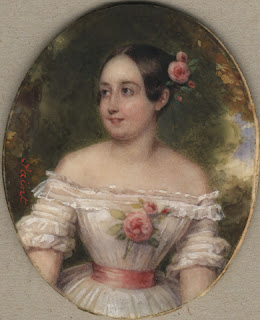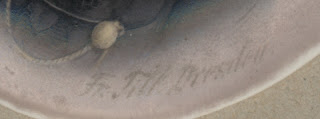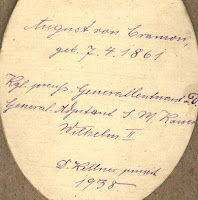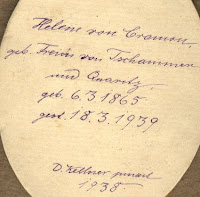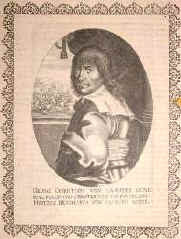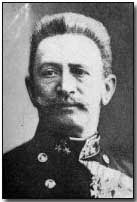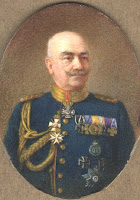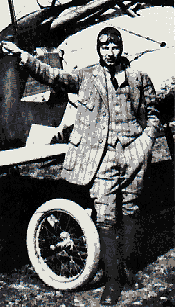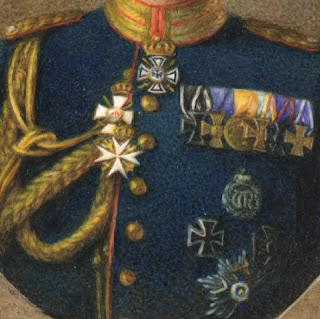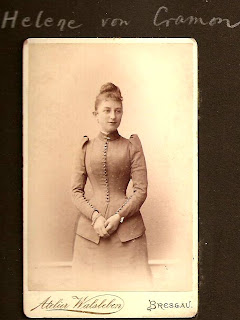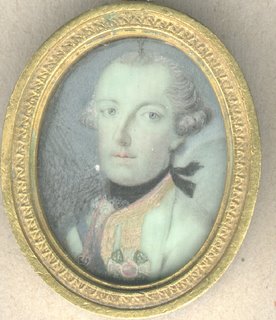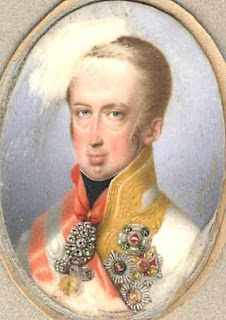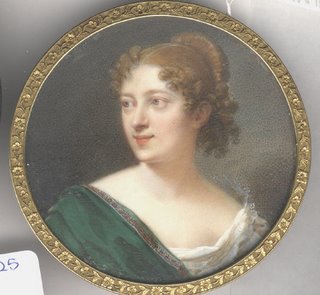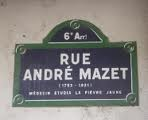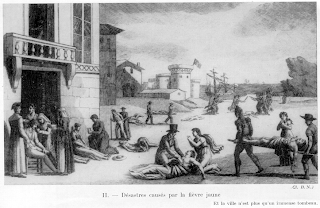![]() A Family at War
A Family at WarRarely does one come across a pair of miniature portraits so well identified as this pair are. The research below shows what can be discovered about the impact of war on a family. Researching these sitters also brings history to life and gives a different perspective to some 20C events.
The following research has not all been confirmed by the von Cramon family, but it appears the family was a true military family with a long and proud military history back to the 17C, which was wrenched apart by events associated with WWI and WWII.
![]()
Apart from the von Cramon family's distinguished military service in both World Wars, such events included August von Cramon's involvement in war reparation disputes after Versailles, a plot to restore the rights of the feudal states in the 1920's, persecution of Jewish members of the family, the bomb plot against Hitler, and the effects of the Iron Curtain. There was also conflicting Nazi Party and SS membership by wider family members leading in at least one instance, to the trial and imprisonment of Udo von Woyrsch, a nephew-in-law, for war crimes.
The story ends in 2008 in a small town auction in Hatfield, Pennsylvania, USA, where the two miniature portraits were offered at an antique auction. The pair were offered as separate lots, but fortunately they both sold below the estimates and so I could afford to buy them. Otherwise they could have been split up for ever.
The artistThe miniatures are both signed on the front and on the reverse by D Kellner, for Dorothea Kellner (1875->1938). Little is recorded about her, but she did exhibit at the Berlin Academy. She was born at Gentzrode/Neuruppin and worked in Berlin, Cairo, Paris, Italy, and Austria. Judging by the apparent age of the two sitters, compared to their actual birth dates, it would seem that Kellner copied the portraits from photographs or other portraits dating to the 1920's.
![]()
![]()
Both miniatures are in silver gilt frames which are hallmarked on the base. The country mark is Germany, the fineness is 925 and a town or maker's mark which appears to be a spouting whale over the letters D G W, followed by a date letter or maker's mark "H". However, the specific hall mark has not yet been located.
![]()
![]()
![]() The von Cramon family
The von Cramon family Identification of both sitters comes from interior inscriptions and also a typed inscription on the reverse.
Inscribed inside the officer is "August von Cramon / geb 7.4.1861 / Rgt preuss. Generalleutnant n D / General Adjutant L M Kaiser Wilhelm II / D Kellner pinxit 1938". The typed note reads "August Friedr. Wilhelm Karl Erdmann v. Cramon geb Pawlau 7.4.1860 gest 20.10. / Gen. Lt. Gen. adjt. Kaiser Wilhelm II 19.40. / Eh, Komend. Ordenshptn. d. Johanniterordens".
![]()
![]()
![]()
Identification of the lady come from the interior inscription "Helene von Cramon / geb Frein von Tschammer und Quaritz / geb 6.3.1865 gest. 18.3.1939 / D Kellner pinxit 1938" and the typed note which reads "Ottilie Therese Agnes Helene v. Cramon / geb. Frelin v. Tschammer u. Quaritz / Brunselwaldau 6.3.1865 - 9.3.1939 x Quaritz 29.9.1887".
![]()
Helene von Tschammer und Quaritz was born 6 Mar 1865 at Brunzelwaldau, Freistadt, in Silesia, then part of Prussia, possibly at Brunzelwaldau Castle as shown here. Her parents were Arthur von Tschammer und Quaritz and Johanna von Lieres (or Jenny von Lieres).
Helene may also have been a sister of Georg Freiherr von Tschammer und Quaritz (1869-October 1918) who was a German politician and State Secretary at the Ministry of Alsace-Lorraine when it was part of the German Empire.
![]()
Lieutenant-General August von Cramon was born at Pawlau on 7 April 1861 (or 1860). At that time, it was a parish of Breslau in the Ratibor district of Upper Silesia and the main language spoken was Polish. His parents were Friedrich August von Cramon (7 Nov 1832-30 Nov 1898) and Katharina von Taubadel (7 Jun 1834-17 Jan 1906) who were married on 14 May 1860. Katharina's parents were probably Wilhelm von Taubadel (1796-1851) and his wife Agnes von Jordan (1799-1854) as shown here in portraits of 1840 by Karl Friedrich Ludwig de Rahden which were sold by Sotheby's in Munich, on 18 May 1988.
![]()
With Wilhelm von Taubadel himself likely to be descended from the Swedish general George Christoph von Taubadel (aka Georg Christoph von Taupadel)(c1600-1647) shown here in 1632 and who fought many battles in the Thirty Years War, in one of which he lost his arm.
A letter recording an incident from this period was sold by Christie's in 2007. It was from Matthias Gallas, Count of Campo and Duke of Lucera (1584-1647), to an unidentified correspondent, on one page in Italian, with a request to take care of the sister, son and possessions of [Colonel George Christoph von Taupadel] the commander of the Swedish army, 'mi fava favore, che sia tenuto cura della sorella figlio et Robba de Tubadel'. Gallas took part in the siege and destruction of Schondorf where the Swedish army in which Taupadel served was routed by the Imperial forces in September 1634. Taupadel avenged the defeat in 1642, after Gallas, who had joined the conspiracy against Wallenstein, had succeeded to the command of the Imperial army.
Wilhelm also probably descended from Ernst Balthasar Siegmund von Taubadel (7 Aug 1724-13 Aug 1802) a Prussian Major General and Commander of Danzig (1793-1795).
Friedrich and Katharina had one other son, Bertram Heinrich Werner Erdmann von Cramon-Taubadel (28 Sep 1869-13 Feb 1952) who adopted the surname von Cramon-Taubadel, This was a result of August inheriting their father's von Cramon estate, while his brother inherited the estate of their mother, Helena Taupadel. (see more about Bertram and his family below)
![]()
There were possibly also two daughters, Katharina Agnes Karoline Marie Erdmute von Cramon (27 Nov 1862-?) who married Lieutenant-General Adalbert Karl Deodat Siegismund von Rothkirch und Panthen (9.11.1853-14.11.1928) on 12 Apr 1882. They had four children;
1. Friedrich Wilhelm Oskar Deodat Siegesmund von Rothkirch und Panthen (16 Feb 1884-24 Dec 1953) who became a Lieutenant-General in the army, see
Friedrich-Wilhelm von Rothkirch und Panthen He was involved in the invasion of France leading the 13th Infantry Division (Motorized), see
General der Panzertruppe Traugott Herr He then led the 13th Panzer Division in Operation Barabarossa, the invasion of Russia, see
The road to Stalingrad2. Elly Helene Toska Katharina von Rothkirch und Panthen (31 Mar 1889-?)
3. Oskar Guido Karl Ludwig Deodat Siegismund von Rothkirch und Panthen (29 Sep 1893-?).
4. Toska Katharina Marie Elisabeth von Rothkirch und Panthen (09 Nov 1894-?) Breslau Stadt, Schlesien, Preussen
Also Karoline von Cramon (26 May 1866-29 Feb 1944) who married Gidein Vollrat Julius Helmold von Plessen on 6 Feb 1887.
The career of August von Cramon![]()
![]()
![]()
Nothing of August von Cramon's early career is currently known, but at the outbreak of war in 1914 he was Chief of Staff for the 8th Corps. However he was soon made the official German observer attached to the Austrian forces during World War I, from early 1915 until some months after the Armistice. (A kind visitor has recently sent me a copy of this print of von Cramon dated 1915)
His November 1915 account of the fall of Serbia can be read at
First World War.com - Primary Documents - The Fall of Serbia by...Von Cramon was instrumental in the lead up to the Asiago Offensive in June 1916 and his report can be read at
First World War.com - Primary Documents - General von Cramon on ...![]()
Later on August 1, 1917 General Von Cramon informed the German High Command that German help was required on the Isonzo front see
La Grande Guerra: Caporetto - A Fresh LookAt a major German conference on 11 May 1918 a memorandum prepared by von Cramon was an important discussion topic when the military relationship between Germany and Austria was discussed. The minutes record; "
Field Marshall von Hindenburg notes that it will suffice in any case if the upcoming meeting of the monarchs discusses General von Cramon’s seven points."Later there was a German military conference on 10 Aug 1918 at Spa, the German Supreme Headquarters. At it, a report from General von Cramon, as the Military Attache in Vienna, was read to the effect that the Austrian Emperor had said that they should make peace in 1918, and if they did not, he would make a separate peace. The postcard below shows Colonel von Cramon in the Officer's Mess in Austria, he is just right of the candelabra. The names of those depicted a
t the table, are a little confusing in the translation, but seem to include; "Conrad of Hötzendorf" sitting Kundmann Colonel, Lieutenant Colonel Graf von Kageneck, Slameczka Lieutenant Colonel Rear Admiral Raisp v. Caliga, Colonel von Cramon, Field Marshal Lieutenant v. Hoefer, Generalmajor Metzger, Lieutenant Colonel Christophori. ![]()
Immediately after WWI in late 1919 General von Cramon was carefully appointed head of the GAPM (German Army Peace Commission) where he often clashed with Allied government and military officials after 1920, as part of a German government policy of passive resistance and vehement opposition to any form of German disarmament.
The GAPM was an unexpected gift to the German government, which had expected the Allies to ride rough shod over their defeated enemy. Instead the Allied powers requested there be a German liaison committee to co-ordinate the disarmament process. The German government saw they could use the GAPM as a means of obstructing the Allied demands for disarmament. From his first meeting with the IAMCC (Inter Allied Military Control Commission) on 20 Jan 1920, von Cramon demonstrated that the policy included power games, obfuscation, and general obstruction.
A report of the initial meeting between the French and Germans in Berlin recorded the following exchange. Germany's representative, General von Cramon, "declares this meeting open."
France's General Nollet intervened, "Stop! It is for me to declare this meeting open. We are in control here!"
Von Cramon responded, "You are a foreign mission, on our territory in time of peace. By all diplomatic precedents it is for me to decide."
Nollet replied, "There are no precedents. The Treaty has made one. The Treaty has placed us in control, and control means supervision."
"Very well," said von Cramon, "then I must report to my government."
"And I to mine," Nollet answered and the two generals left the room. Back at the Hotel Bellvue, General Nollet angrily told his staff that he has beaten the Germans four times in battle, and he will not lose now.
![]()
As a result of these delaying tactics, the Germans were able in 1920, amongst other things, to spirit away or hide in remote barns, stables, sheds and cellars over half of the Fokker airplane factory machinery and vital parts, leaving less than half of the inventory for the IAMCC inspectors to find.
The Fokker F-7 being the only item of German war equipment named in the Versailles Treaty as being required to be completely destroyed.
![]()
The concealed items were later in 1920 all smuggled to Holland in six train loads totalling in all, 350 wagons, so that Fokker could appear to operate from a neutral country. The smuggled train loads included 200 airplanes and 400 engines, as well as much machinery.
In addition Tony Fokker (shown here in 1914) smuggled to Holland the 25% of his total assets which he held in the form of cash, half by sailboat and the rest in a decrepit suitcase sent as diplomatic luggage. For more see
Military Deception and Strategic Surprise - Google Books ResultThe French government believed that the task of von Cramon was simply to discredit the IAMCC, to such a degree that Foch declared "the War is not yet over". Von Cramon held a similar view and German nationalists referred to the IAMCC as "the hyenas of the battlefield".
Von Cramon wrote the 205 page book pictured here about his WWI experiences titled "Unser Österreichisch-Ungarischer Bundesgenosse im Weltkrieg" or "Our Austrian-Hungarian Confederation in the World War" which was published by Ernst Siegfried Mittler und Sohn, Berlin 1920. This book has been described as "unsurpassed for gaining an insider's view of Austria's army at war, on the Isonzo and elsewhere".
![]()
It was tranlated into French in 1922 as "Quatre ans au G. Q.G. austro-hongrois pendant la guerre mondiale comme représentant du G. Q.G. allemand. Traduit par le capitaine Koeltz."
In 1921/22 he wrote "Fort mit den Interalliierten Kontrollkommissionen. (= Flugschriften des "Tag" Nr. 14 / und: Die Maßnahmen der Interalliierten Militär-Kontrollkommissionen gegen die Deutsche Werk A.-G. Herausgegeben von den Spitzenverbänden der Deutschen Gewerkschaften (Allgemeiner Deutscher Gewerkschaftsbund, Allgemeiner freier Angestelltenbund, Deutscher Gewerkschaftsbund, Gewerkschaftsring Deutscher Arbeiter-, Angestellten- und Beamtenverbände. 2 Schriften in 1 Band."
I think this translates as something like; "Doing away with the IAMCC (report No 14). The measures of the IAMCC against the German workers. Allow a central association of the German trade unions (general German trade union federation, general free employee federation, German trade union federation, and the trade unions of German workers, employee and official federations). 2 writings in 1 volume."
Von Cramon also wrote another military book in 1932; "Deutschlands Schicksalsbund mit Österreich-Ungarn. Von Conrad von Hötzendorf zu Kaiser Karl" or (I think); "The fate of Germany federation with Austria-Hungary. Von Conrad and von Hoetzendorf to Emperor Karl."
The broader pictureThe IAMCC realised much too late it had been a mistake to require the establishment of the GAPM. Perhaps the Allied negotiators had forgotten that the German government was not familiar with the phrase "it is not cricket".
The NY Times reported on Dec 29, 1920 "Once more the French are talking about occupying the Ruhr Basin. More than anything else this is probably a play for position in the discussion of reparations which reopens in Brussels on Jan. 10, and is a threat made to counteract the German threat that if the French do not treat them better they will take back all the nice promises they came near making at Brussels two weeks ago." see
FRENCH AGAIN TALK OF OCCUPYING RUHR; Say Germany Seeks to Play ...
When the French and Belgians did indeed move to occupy the Ruhr in 1923-1925, General von Cramon resigned leadership of the German Peace Commission post claiming that "French soldiers hung German civilians by their feet and crushed their skulls". Although a strong claim, there were instances of repression by the occupying forces. In the event, the Red Cross was called in and this was the first time the Red Cross conducted an investigation to see how the civilians were affected, see
The occupation of the Ruhr (Germany, 1923-1925)The claim also did appeal to many Germans as someone to blame for the crippling effects of hyper-inflation which were spreading across Germany. The onerous WWI reparation payments required from Germany and consequent hyperinflation within the country, became major factors leading to the rise of Adolf Hitler and Nazi Germany.
At
Germany and Coalition Warfare in the World Wars: A Comparative Study the author Raffeel Scheck suggests from looking at several early 1920's right-wing plots in detail (three led by von Tirpitz (19 Mar 1849-6 Mar 1930) and one by von Cramon and Helfferich) that they were were willing to go as far as an armed putsch if necessary. They were also willing to run the considerable risk of an armed conflict with France in the process.
Scheck establishes a widespread pattern of thinking which sought to force the Reichstag to name a national government led by a man or men chosen by the conspirators which would repudiate both the constitution and the Versailles Treaty, re-arm, and "restore" the rights of the federal states. This was to be done with Reichswehr support and under the armed pressure of the paramilitary leagues. Popular support for such measures was to be gained through media manipulation and the forcing of a confrontation with France. However, none of these plots came to fruition.
The probable aim in the mind of August von Cramon, was not a literal return to the 19C, but a recognition that a unified Germany had led to a disaster for the country in World War I. He may have thought that there were a risk of further militarism, as indeed happened with rise of the Nazi party, which might also lead to a second disaster for the general population. As he was a high ranking army officer and diplomat based in Vienna, but had not personally been in a position of defeat on the front during World War I, he was uniquely positioned to view the events in Germany a little more dispassionately than those fighting on the front or at headquarters in Berlin. With those views in mind, von Cramon likely thought that a constitutional monarchy would not be acceptable to the Allies, but they might accept a return to the German States political structure of the 19C.
With the benefit of hindsight, such a return to the German States would have prevented World War II, and led to a lot more stability in Europe. Europe would look a much different place in the 21C with many more prosperous small countries of the size of Luxembourg, Lichtenstein and Monaco.
In May 1926 General August von Cramon informed the Ex-Kaiser (shown below along with his son, Crown Prince Wilhelm in a miniature portrait from this collection, see
View) about the United Vaterländischem associations of Germany, and the need to strengthen President Hindenburg with advice of the Kaiser's own preferences: "In the future is dictatorial rule. You need to make a decision, whether to go to the right or left, whether it be monarchy or republic. The sooner the decision is made, the better." See
70 ZEITLAUFTE![]()
![]()
From this distance it is a little difficult to fully evaluate von Cramon. He was obviously involved in many political machinations at the Austrian Court during WWI, so would have learned a lot about "playing the political game".
He must have known well, all the major power brokers in Germany in the 1920's and 1930's.
It appears with the GAPM in the 1920's he was scrupulous in following German policy dictates. Given his membership of the Order of St John, and the various comments here, he seems to have been an honourable man concerned about the move towards a dictatorship within Germany.
Judging by the inscription on the miniature and the research undertaken as recorded here, it appears von Cramon was an aide to the ex-Kaiser during the latter's exile in Holland. They were both officers of the Order of St John and there is a reference to von Cramon being one of several visitors to the Kaiser for his 80th birthday on Jan 27 1939 at
Meine Erinnerungen an Wilhelm IIThe newspaper photo shows August in a procession, as a member of the Order of St John. He is the one who is leading the procession. From von Cramon's shared membership of the Order of St John with the Kaiser, and especially given he had the miniature painted in 1938, the year a decree was issued banning officers from belonging to St John and to the Nazi Party, it seems certain von Cramon was "old school" and thus opposed to Hitler and Nazi Germany.
A question for other historians to consider, is whether von Cramon was ever in a serious position to prevent the rise of the Nazi Party. Von Tirpitz had died in 1930 and von Cramon turned 70 in 1931, so was probably too old to seriously consider running for political office himself. As he had not been a field officer during World War I, his name was not known to the public and thus he had no wide base of support.
However, I feel von Cramon was not far off being in a position to successfully act as a rallying point against Adolf Hitler and the Nazi Party.
With the benefit of hindsight, the Allies would have been far better advised to have left the Kaiser as head of state, with reduced powers, rather than forcing his abdication. It would have been impossible for Hitler to have achieved power, had the Kaiser still been the nominal head of state.
After WWII Emperor Hirohito was retained with reduced powers and so revolution was never an issue in Japan.
Also, the Allies realised that reparation payments were likely to cause unrest, so it was better to grow the economy of Germany after WWII through the Marshall Plan, than punish it as happened after WWI.
![]() The Order of St John and the July bomb plot against Hitler
The Order of St John and the July bomb plot against HitlerA close up of von Cramon's decorations is shown here for any interested medal collector - see full key of the medals and decorations further below which was provided by a kind member of the von Cramon family.
Also shown for any medal collecting visitors to this blog, is another miniature in enamel on copper, of a well decorated German officer from this collection painted by Adolf Helzel, - now identified as Crown Prince Ernst August of Hanover, Duke of Cumberland and Teviotdale.
He is believed to be the only man to be a senior officer in armies on both opposing sides, the German as a colonel, and the British as a general, in World War I, see View)![]()
The Order of St John decoration worn by von Cramon is interesting, as on 2 July 1938, being the year his miniature was painted, Rudolf Hess issued a decree (78/38) from Adolf Hitler, which forbade anyone having common membership of the NSDAP and the Order of St John.
At this time only about 10% of the Order members had become National Socialists.
The Order was not dissolved or forbidden by the decree, but it could not accept new members. The Order remained, with members now wearing a finger ring with a medal cross.
Later, a number of German members of the Order of St John were involved in the July 1944 bomb plot against Adolf Hitler and were subsequently executed. No doubt those members of the Order were well known to von Cramon and, if he had still been alive in 1944, it seems entirely probable he would have been in favour of the plot.
![]()
In fact one of the brave plotters who was executed on Aug 30, 1944 was Karl Ernst Rahtgens shown here, who was married to Johanna Helene Rahtgens, nee von Cramon.
After gaining his school-leaving certificate, Karl Ernst Rahtgens decided on an officer’s career and joined a Potsdam infantry regiment in 1928 as an officer cadet senior grade. He married Johanna von Cramon, with whom he had a daughter and two sons. In 1937 Rahtgens passed the entrance examination for the War Academy, and was transferred to general staff training in Berlin in 1938. In the early years of the war he fought on various fronts. In 1942 he was detached as lieutenant colonel on the general staff to the “Führer’s” headquarters, the “Wolf’s Lair”, near Rastenburg in East Prussia. He became friendly there with Günther Smend, with whom he discussed the war situation. These discussions coincided with the views of Rahtgens’ uncle, General Field Marshal Günther von Kluge, who sympathized with the resistance for a while, but eventually wavered. Rahtgens was involved in the preparations for the coup attempt of July 20, 1944. He was arrested by the Gestapo in Belgrade in August 1944. Karl Ernst Rahtgens was sentenced to death by the People’s Court on August 30, 1944 and murdered the same day in Berlin-Plötzensee. see
GDW - BiographienJohanna von Cramon was a granddaughter of General August von Cramon and, like her husband and grandfather, a very brave lady. Her father was Friedrich August Emil Arthur Kurt Erdmann von Cramon.
Johanna was reportedly interviewed in early 2008 for a proposed new documentary starring Tom Cruise and directed by Bryan Singer, when Johanna was the last living widow of one of the executed plotters, see
OPERATION VALKYRIE: THE PLOT TO KILL HITLER When interviewed, Johanna gave an emotional account of her husband being dragged before the judges. Karl and Johanna Rahtgens had a daughter and two sons.
![]()
Although I have not read it, there appears to be a 248 page paper-back book about the life of Johanna Rahtgens, written in German by Johanna Helene Erdmute Rahtgens, and titled "Abschied und Neubeginn", (I think this translates as "Farewell and a New Beginning") ISBN 3833489189
The cover is shown here and it appears to be available as a print on demand book for 20 Euros, see
BoD - Books on Demand GmbH: AutorenPortrait
The family of August and Helene von CramonAugust von Cramon died on 19 Oct 1940 at Quaritz, Schlesien, Prussia. He and Helene were married at Quaritz on 29 Sep 1887 and had five children.
1.Friedrich August Emil Arthur Kurt Erdmann von Cramon (15 Jul 1888-9 Sep 1934) who married Anna Elisabeth von Prittwitz und Gaffron on 21 Jun 1915.
2.Gunther Theodor Otto Erdmann von Cramon (26 Nov 1889-24 Mar 1945) who married Alexandra von Winterfeld on 3 Aug 1935
3.Helmuth Georg Johannes Adalbert Wilhelm Erdmann von Cramon (6 Oct 1892-20 Nov 1966) who married Magherita (or Daisy) Gruschwitz on 23 Sep 1916. He was an export merchant.
4.Johanna Charlotte Katharina Therese Antonie Helene von Cramon (14 May 1898-25 Mar 1982) who married Ernst Heymann on 13 Sep 1921. He was Jewish and was sent to Theresienstadt concentration camp in Aug 1944. This was despite his distinguished WWI record. In 1912 he completed the baccalaureate examination on the Wilhelm Gymnasium in Berlin, in May 1914 he joined the Air Force in 1915 until 1919 as a captain in the Air Force. Heymann was severely wounded several times, was awarded the Iron Cross class I and II and was recommended for the Order of the House of Hohenzollern. They were married as Protestants and the family lived in Holland, see
Theresienstadt Lexikon: Ernst Heymann5.Agnes Elisabeth Antonie Susanne von Cramon (19 Oct 1903-20 Mar 1970) who married Fritz Laack (1900-1990) on 30 Mar 1935. Fritz Laack was an educator, see
Kurzbiographie Fritz LaackThe history of the pair of miniatures from 1938 until they were sold at auction in Hatfield, PA, USA in 2008 is currently unknown. All the above children died in Germany. It seems the family may have lost all their estates at the end of WWII, as the estates would have ended up behind the Iron Curtain in Poland and so perhaps a branch emigrated to America after WWII.
Moni von Cramon and the Nazi PartyAlthough it is not yet clear where she fits into the family, if at all, but at least one von Cramon was involved with members of the Nazi Party, as least for a time. See quote; "Earlier, in September 1934, the aristocratic lady Moni von Cramon, one of the leading German Buchmanites, was personally invited to the Nuremberg Nazi Party rally by Heinrich Himmler. Moni, in turn, invited Frank Buchman." Also "In August 1935, Frank Buchman and Moni von Cramon were again invited to the Nuremberg Nazi Party rally by Heinrich Himmler, and again they discussed religion and politics with Himmler." quoted at
Religious Roots: Nazi Partying and
Oxford Group - Wikipedia, the free encyclopediaFrank Buchman was a Swiss American who founded the "Oxford group"which started as a Christian Group, but later widened its activities to provide "an ideology for democracy" in the struggle against Communism.
Bertram von Cramon-Taubadel and his familyThe family of General von Cramon's brother, was also affected by WWII. Bertram Heinrich Werner Erdmann von Cramon-Taubadel (28 Sep 1869-13 Feb 1952) achieved the rank of Major and married Suzanne von Jordan (8 Apr 1875-1 Jul 1959) on 21 Apr 1897. They had several children, all of whom died in Germany:
1. Hans Juergen Erdmann von Cramon-Taubadel (14 Nov 1901-6 Nov 1985) who married firstly, Viola von Kaufmann-Asse (17 Aug 1912-4 Nov 1997) on 16 Nov 1933 and secondly, Ilse Wehrs (8 Nov 1919-16 Jun 1988) on 5 May 1948.
2. Reimar von Cramon (23 Dec 1904-14 Jul 1987)
3. Renate Katharina Susanne von Cramon (4 Nov 1906-5 Apr 2003)
4. Susanna Catharina von Cramon-Taubadel (29 Sep 1915-8 Nov 2002) who married firstly, Hermann von Kapp-Herr Lockwitz on 27 Apr 1943, secondly Eckhard von Schack on 14 Feb 1948 and thirdly, Wilhelm von Karnap on 6 Feb 1976. Her first husband, Hermann von Kapp-Herr was a fighter pilot killed on 24 Apr 1944 after less than a year of marriage. He was credited with 7 kills.
Some references suggest that two children continued to use the name Von Cramon-Taubadel, and two reverted to the name von Cramon.
The reason for this may be connected to the following event in 1940. I am indebted to Rick Kent of www.ipmsstockholm.org for the following information, see
Camouflage & Markings of Messerschmitt Me 109![]()
"The picture is of the Messerschmitt Me 109E-3, of Stab, JG53 flown by Major Hans-Jurgen von Cramon-Taubadel (Geschwader Kommodore) from Thevile-Maupertus (Cherbourg-Ost), France, August 1940"
"This 109E-3 has an interesting story attached to the markings. Major von Cramon-Taubadel was married to a Jewish wife, Viola von Kaufmann-Asse, a fact which came to the attention of Hermann Goering during the Battle of France. As a result Goering ordered that the whole of JG 53 must remove their famous Ace of Spades badge and paint a red band around the noses of their aircraft as a mark of shame. In the Autumn of 1940 von Cramon-Taubadel was removed as Geschwader Kommodore and Goering told them they could reinstate their "Pik-As" badge; this they did but at the same time, as a mark of protest, all the pilots of JG 53 had the Swastikas painted over on their aircraft. Thus it is easy to recognise JG 53 109's late in the Battle of Britain as they have no Swastikas on them."
"The profile shows Major von Cramon-Taubadel's aircraft with the red band marking when the Geschwader were operating from Cherbourg and the Channel Islands during the Battle of Britain."
(In a strange way this has a connection with me as a collector, as my parents honeymooned at St Peter Port, Guersney, Channel Islands in 1937 and met my subsequent godmother, Dorothy Falla (Doff Falla) who was a resident of the Channel Islands during the German Occupation.)The Geschwader commanded by Major von Cramon-Taubadel was one of the most effective during the Battle of Britain, claiming 258 kills for 51 pilots killed or POW. For more on this, see
Jagdgeschwader 53 - Wikipedia, the free encyclopedia Thus it maybe that two of Hans-Jurgen von Cramon-Taubadel's siblings dropped the Taubadel from their name as a result of Nazi pressure associated with his Jewish wife. Later in WWII, from Nov 1943 to 18 Dec 1944 Oberst Hans-Jürgen von Cramon-Taubadel was Chief of Staff of the German Airforce in Finland.
The von Tschammer und Quaritz family and the Nazi PartyOn Helene von Tschammer und Quaritz's side of the family there seems to have been a closer connection with the Nazi Party. The following comes from
Udo von Woyrsch – Wikipedia Udo Gustav Wilhelm Egon von Woyrsch (24 Jul 1895-14 Jan 1983) was married on 21 Sep 1934 to Inez Freiin von Tschammer und Quaritz (21 Dec 1908-?) the daughter of Siegfried Freiherr von Tschammer und Quaritz and Edith von Lieres und Wilkau. Thus Inez was probably the niece of Helene.
Von Woyrsch was an officer in WWI, but in 1921, took over his father's estate. Early on, he joined the Nazi Party (No. 162,349) and SS (No. 3,689). On 1 Jan 1935 he was appointed SS-Obergruppenführer, the then second-rank in the SS.
In 1934 von Woyrsch during the Röhm-coup, ordered the shooting of his rival Emil Sembach. From Mar 1933 to the end of the war, he was responsible for the constituency of Wroclaw member of the Nazi Reichstag. In addition, he was appointed to the Prussian State Council.
On 3 Sep 1939 Himmler appointed him "special commander of the police" and he received command of the Operations Group V. campaign in Poland. On 15 Apr 1941 he became General of the Police Board. From 20 Apr 1940 to 11 Feb 1944 von Woyrsch was a police leader, but he lost this office, because he was involved internal Nazi intrigues in Dresden.
Woyrsch was, in 1948, sentenced to 20 years in prison, because of his "membership in a criminal organization", but in 1952 was released. In a second trial in 1957, concerning the Rohm-coup, he was sentenced to 10 years in prison, but was released in 1960.
SummaryIt is sad to view the 1938 portraits of August and Helene Von Cramon when they were proud and respected. Shortly thereafter, in early 1939, they attended the 80th birthday of the Kaiser, but Helene died later that year and August died in 1940.
Later, one of their nephews was persecuted by Goering for having a Jewish wife, the husband of their granddaughter was executed for being involved in the July 20 1944 plot against Hitler, and a son-in-law was sent to Theresienstadt concentration camp. A nephew-in-law was imprisoned for war crimes. Quite likely after WWII the family lost any estates which were situated behind the Iron Curtain.
![]()
The miniatures above show August and Helen von Cramon at their peak and they would have been devastated if they could have known what would happen to the family after 1938. With losses not only from WWII itself, but apparent internal family conflicts arising from the effects of Jewish persecution and involvement with the Nazi Party.
Although there was not a civil war as such, in Germany in the 1930/1945 period, the conflicts within families have parallels with the family conflicts that arose within the English Civil War of the 17C and the American Civil War of the 19C.
That is not to say any one of these eras was more or less honourable than another, but in each case families were sadly torn apart by the beliefs of certain family members who found themselves on different sides of the idealogical division.
Final words![]()
As a collector this research brings some events of the first half of the 20C into sharp relief, and it is a little humbling to know that these two miniature portraits were handled by someone who must have shaken hands with Kaiser Wilhelm, Emperor Franz-Joseph of Austria who died in 1916 (the extra image of an Austrian officer is not Emperor Franz-Joseph, see
View in this collection), Emperor Charles I of Austria, President Paul von Hindenburg of Germany, and no doubt also at some stage the various Nazi leaders. 1319, 1320
Later - Alix von Cramon has kindly supplied further attractive images of August, c1909, and Helene, c1890, together with the following image of the honors and decorations of August von Cramon, together with a key to their names. Clicking on the images should link to larger versions.
![]()
![]()
![]()
![]()
![]()
A kind German speaker has provided a preliminary translation of the decorations, which may need minor revisions;
1 Royal Prussian red eagle order, commander of an order, on oak leaves and swords and crown on a black and white band.
2 Royal house order of Hohenzollern, commander of an order with swords on a black and white band
3 Royal Bavarian military earned order star with swords
4 Royal Bavarian military earned cross, second class, with crown and swords
5 Badge of rank of the Royal Prussian flank adjutant
6 Royal Belgian Leopold's order, commander cross with swords
7 K&K Austrian war memory badge from 1929
8 German "Iron Crosses from 1914", first and second classes
9 Turkish "Iron Half-moon"
10 Grand Duke of Mecklenburg Griffin order, Silhouette cross
11Prince of Lippe cross of honor, second class with oak leaves and swords
12 Royal Bavarian military badge 2nd class before 1905
13 Holder with dates 1859-1929 on a band of the Royal Prussian Hohenzollern badge to remember the 70th birthday of Kaiser Wilhelm II.
14 Hungarian St Stevens order, Silhouette Cross
15 Grand Duke of Oldenburg war cross first class
16 Epaulette of a general lieutenant and general adjutant of Kaiser Wilhelm II (name badge and crown)
17 Royal Bulgarian military order, star and badge on a shoulder band
19 Royal Italian St Mauritius order and Lazarus order
20 Japanese Imperial order of the holy treasure
21 Austrian Imperial Marianne cross on a band of the German Knight Order
22 " " Leopold's order commander cross with war decorations
23 " " Badge of bravery silhouette
24 " " Order of the "Iron Crown with war decoration
25 " " Military badge 2 class
26" " " Order of the "Iron Crown" Big Cross, star and order on a shoulder band
27 Belgian Leopold's order, commander cross
28 Austrian Imperial Franz-Josephs order
On the badge clip from left to right:
Bavarian military badge, 3rd class, in gold
Badge of St.Michael, knights cross
Grand Duke of Mecklenburg house badge of the Wendish crown
Grand Duke of Oldenburg, house and earned badge, Knights cross,
Royal Sachsen, Albrecht's order, Knights cross.
Much later, February 2013 - A descendant of August and Helene who lives in the United States, Benjamin von Cramon has recently found some interesting film fragments among the family papers. He advises
; 'Here's a link to the 16mm footage featuring August and Helene von Cramon:
http://vimeo.com/60323749. I have nothing but questions about this man, his role in the events of the first and possibly second World War. I'll keep you posted as I learn.
And here's a link to the very interesting 35mm nitrate footage I told you about:
http://vimeo.com/60254050. Both clips have audio.
'Benjamin would be very happy to hear any further information about the clips if any visitor can assist?
 This miniature portrait has an inscription on the front that reads "H Michel 1820". This was first thought to be the signature of the French artist noted in Blattel, and in Lespinasse, as active around 1810.
This miniature portrait has an inscription on the front that reads "H Michel 1820". This was first thought to be the signature of the French artist noted in Blattel, and in Lespinasse, as active around 1810. However, the naming of this miniature is made even more confusing, as inside the frame there is a piece of paper that appears to read "Monsieur Leroy do (ditto?) fixet (?) 1807".
However, the naming of this miniature is made even more confusing, as inside the frame there is a piece of paper that appears to read "Monsieur Leroy do (ditto?) fixet (?) 1807".
 Also, "Cior must have produced much and possibly sold his miniatures cheaply. In this period his miniatures all all done in the same way: the faces almost front view, with rather pale blue shadows, a sky background in gouache, with the of some leaves on the right and with the signature Cior ending on a spiral on the left."
Also, "Cior must have produced much and possibly sold his miniatures cheaply. In this period his miniatures all all done in the same way: the faces almost front view, with rather pale blue shadows, a sky background in gouache, with the of some leaves on the right and with the signature Cior ending on a spiral on the left." As of September 2007, Boris Wilnitsky has a miniature by Cior with very similar facial features and style, shown here and displayed on his website at Boris Wilnitsky Fine Art - Homepage1167
As of September 2007, Boris Wilnitsky has a miniature by Cior with very similar facial features and style, shown here and displayed on his website at Boris Wilnitsky Fine Art - Homepage1167
